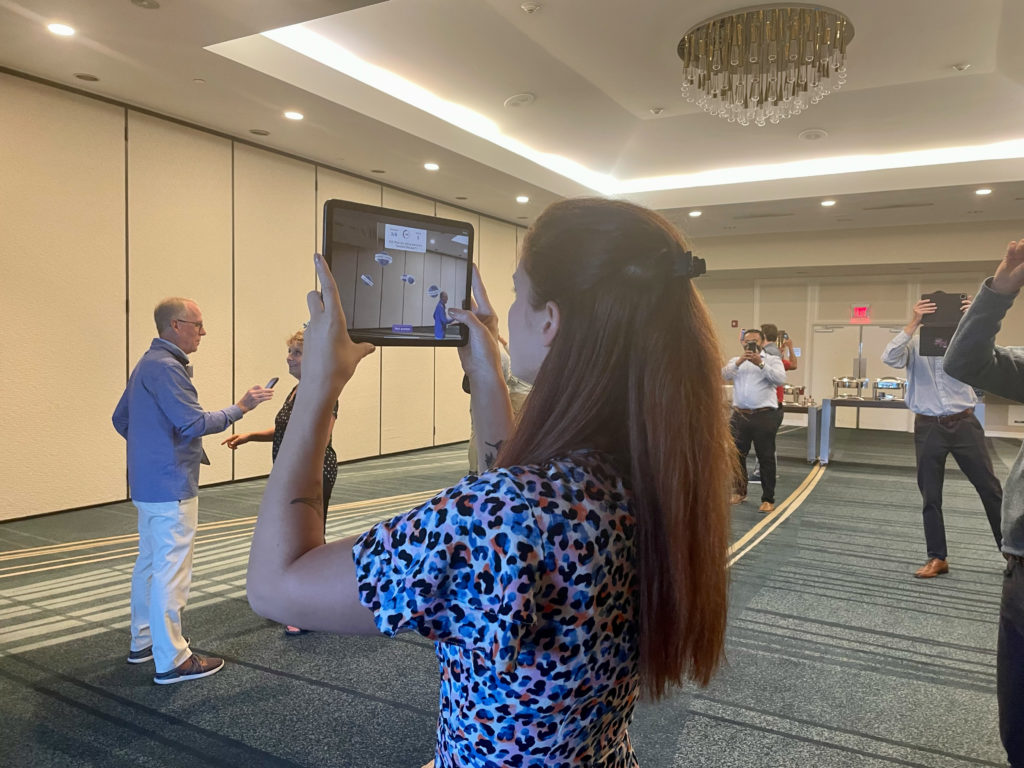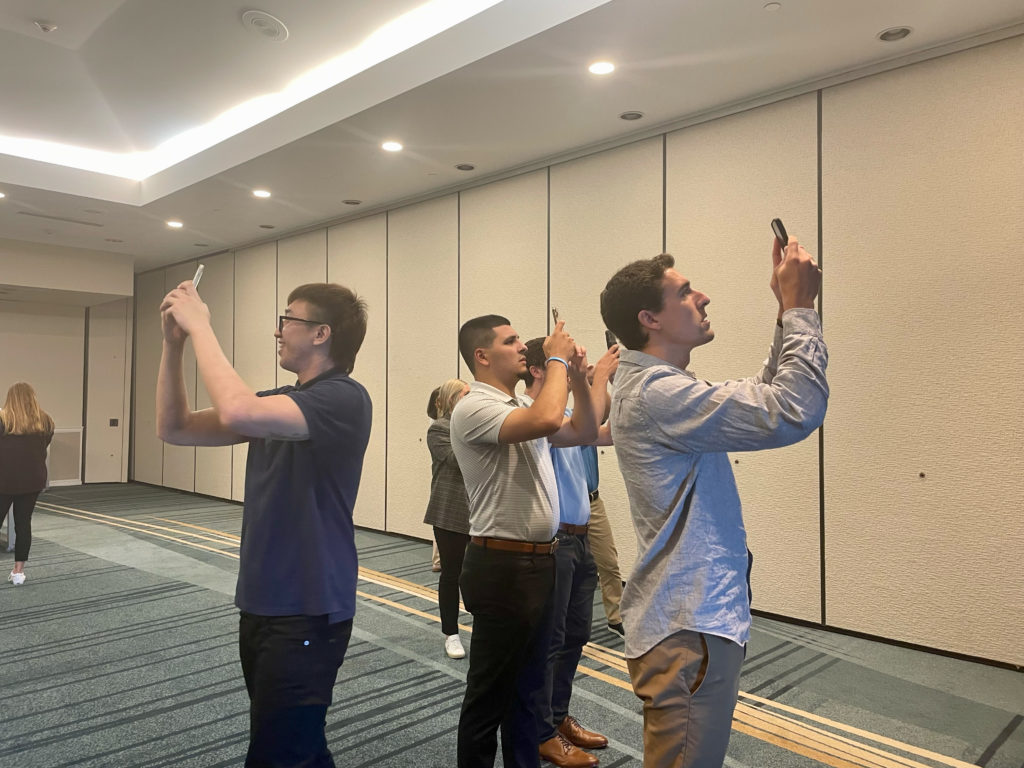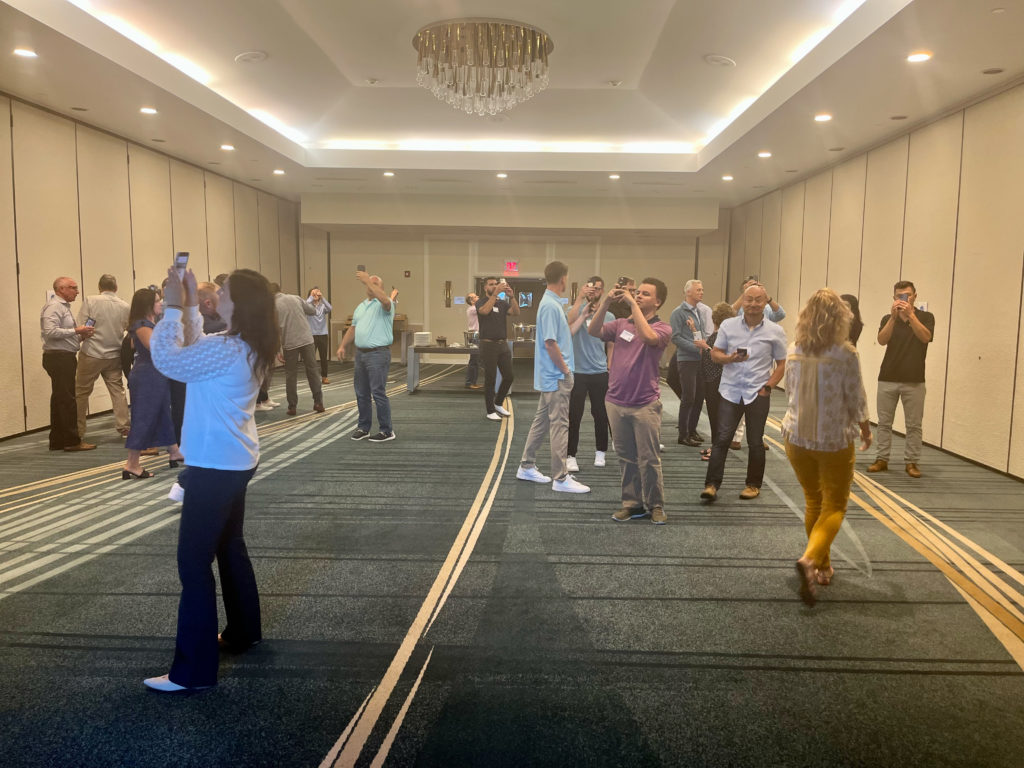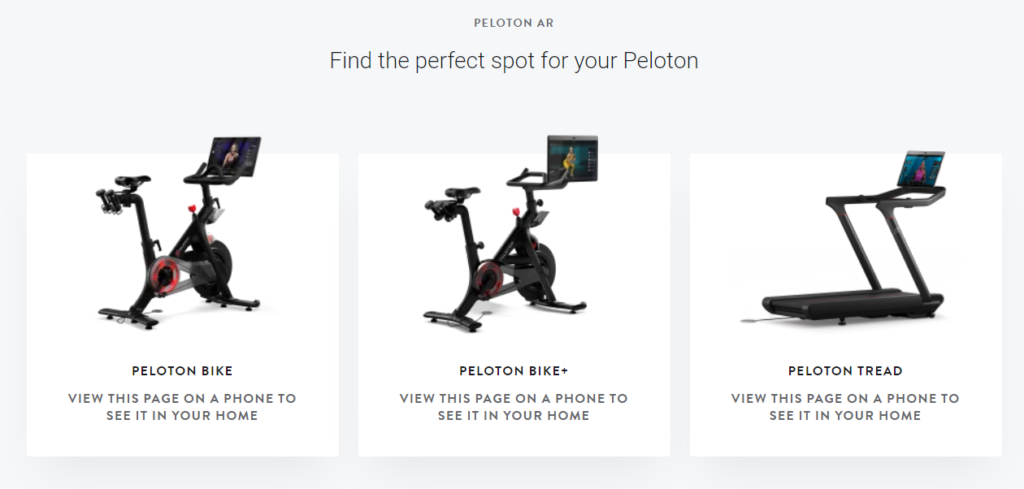We do a lot of sitting and staring these days. Two-hour commute, six hours in the desk chair, two hours watching Netflix — and so on. We’re also confronted with new information every day, every hour.
So it’s no surprise that sitting and staring at a screen while getting bombarded with information is not the most engaging way for employees or customers to learn about your products — or to remember much of what they learned.
All the most effective lessons and most memorable experiences are interactive, immersive, and have a touch of novelty. Countless studies — conducted recently and dating back to the 90s — have linked movement and “the use of active-learning strategies over lecture-based methods” to “higher retention of core content” and better skill development.
Enter augmented reality (AR).
Engaging buyers and learners with augmented reality
A recent NielsenIQ global survey concluded that “A/VR technology will transform brand engagement” and found that “global consumers listed A/VR as the top technology they’re seeking to assist, amplify, and augment their daily lives with 51% saying they are willing to use this technology to assess products.”
Citing the same study, an article from Harvard Business Review listed education as one of the three main business cases for AR, along with entertainment and evaluation.
Our own experiences, and those of our customers, back up these claims.
Whether you’re reinforcing a sales methodology at a sales kickoff event, demonstrating a product to customers at a trade show, or teaching reps how to use and sell a new medical device or retail merchandise, augmented reality experiences are quickly becoming the most exciting and effective way to engage audiences, transfer knowledge, and increase knowledge retention.
In this article, we’ll look at several business cases for augmented reality, including:
- How Bigtincan uses our own AR products for sales training in-house
- How Bigtincan clients are using it for customer engagement
- Different ways to create AR experiences with Bigtincan and Brainshark now
- Where the industry is going in the near future
Using AR to reinforce methodology at sales kickoff

Bigtincan recently began our new fiscal year and kicked it off with a bang! We’re fans of “drinking our champagne,” so part of our sales kickoff included an augmented reality game built with our own solutions called MEDDPICC Galaxy. The AR game was used to reinforce MEDDPICC criteria.
For those not familiar, MEDDPICC is a sales methodology for complex sales commonly used by B2B SaaS enterprises. Broken down, the acronym stands for:
- Metrics: Leverage of the measured potential gain and their economic benefit
- Economic Buyer: Interaction with the person in the account who has discretionary access to the funds
- Decision Criteria: Criteria used by the customer to select the solution and the vendor
- Decision Process: Process that the customer has adopted which leads the purchase decision
- Paper Process: Approval process in the account through which the purchase order request needs to go, before reaching the vendor
- Identify Pain: Actual pains at the company which would require your product/service to be relieved
- Champion: Powerful & influential persons at the company, who are favorable to your solution
- Competition: Knowledge of the competing vendors in the account, their strengths and weaknesses and their champions (source).
You can see the activity for yourself in this video:
A note from our Head of Sales Enablement Beverlie Heyman, who helped plan and develop the game:
"It may look like these sales reps are walking around aimlessly, but that isn’t the case. This is how Bigtincan educated our teams on our augmented reality solution while reinforcing MEDDPICC in a fun way!
As Sales Enablement Practitioners, we have to find ways for our revenue teams to be more productive and effective in their roles, while making sure reps are actually eager to learn and retain the knowledge that is critical to their success.
So when the Bigtincan sales enablement team was putting together our sales kickoff, we took on this challenge by building an augmented reality game to reinforce MEDDPICC.
If your sales organization is like ours, MEDDPICC is often an issue, and we see delayed deals because our sales reps didn’t nail all the criteria needed.
So we took the opportunity to use our own AR technology to train our reps further in MEDDPICC (while alleviating the after-lunch doldrums).
Since we were looking for a way to reinforce MEDDPICC, we developed questions that would reinforce it in an engaging way that helps retain more of the criteria.
During the event, we moved the reps into a room where once they downloaded the QR code. The reps then used their phones to explore our MEDDPICC gallery. On their phones, they were prompted with a specific question. As you can see, they then navigated the galaxy to choose the right answers to the question.
The reps completed these 8 questions and were immediately provided a score showing their successes and challenges.
As you plan your own SKO, this is a great exercise to consider.
What I loved about this activity was that the reps were excited to participate. They appreciated this new modality to learn. And now that we are all back working our accounts, many reps have approached me sharing how they have applied some of the lessons from the game review to their deals. And as sales enablement practitioners and sales leaders, isn’t that what we all want to hear?
I urge you to take a closer look on how you too can leverage AR for a fun learning experience."

Compared to previous MEDDPICC trainings done internally, the AR session improved engagement by getting the reps out of their seats and giving them a tactical experience to associate with the content for better knowledge retention. Here’s what some of our reps are saying about the AR learning experience:
“The MEDDPICC AR game was a great experience because it added a bit of competitive pressure. It made you think on your feet — both figuratively and literally! More importantly, it helped me identify areas where I could improve. It's more of an "in-the-moment" experience rather than just answering questions in a quiz. Not unlike the difference between a video coaching experience and just practicing your pitch out loud.” -Luke Hinson, Account Executive

“It was great getting everyone out of their seats to do something interactive after a lot of presentations and it tested our knowledge on sales concepts. It was a fun way to meet other people playing the game and talk about a shared experience/out of the box thing you were all doing together.” -Sandra Crawford, Senior Product Marketing Manager

You can also watch our augmented reality scavenger hunt from SKO 2024 here.
How to get your sales teams started with augmented reality NOW
If the concept of using AR for sales training has your head spinning with questions about how to fit all the right pieces together and present them to your teams — don’t worry. The barrier to entry for AR is lower than you think. Virtual reality (VR) may still require expensive headsets, but AR and mixed reality are very accessible. In fact, you can start using them now!
Like our MEDDPICC game, the best AR leverages 3D objects that are inserted into your environment. But an easier entry point is inserting 2D interactive content into a 3D world, enabling you to leverage your existing content in a 3D environment in creative and novel ways that make your teams more receptive to learning.
It's a way to get up and running with these tools now while using it as a stepping stone into the broader extended reality space, which has massive potential for training and selling as the technology develops.
And Bigtincan customers are already taking advantage of augmented reality to teach, demonstrate, and sell their products.
Explore the new AR/VR buyer experience reality with Jim Lundy, CEO of Aragon Research in this on-demand webinar.
NeoGenomics case study: augmented reality experiences for trade shows
NeoGenomics is a high-complexity CLIA-certified clinical laboratory, pharma services and information services company that specializes in cancer genetics diagnostic testing.
Before implementing Bigtincan, they had no internal experience with creating immersive XR experiences. Within a few months, they were putting Bigtincan XR to work at trade shows.
At the ASCO 2022 trade show in Chicago, NeoGenomics used a combination of Content Hub and Bigtincan XR to design an AR game that drove booth activity and customer engagement at their biggest event of the year.
The game required users to point their tablet or phone at the target image and then launch into
experience where they had to find and collect various floating molecules which appear around them.
The AR experience drove larger than anticipated crowds to their booth and they received tremendous feedback on site from conference attendees.
Watch conference attendees interacting with NeoGenomics’ booth here:
More ways to engage buyers and learners with augmented reality
While games like these are a popular and fun option, there are tons of possible ways to engage your customers and teams with AR, including:
Learning scavenger hunts or escape rooms
These are two more possibilities for AR games where all of the items are hidden in AR and players must find them or complete a series of actions to win. Like the MEDDPICC Galaxy game, they get people moving around and working together to find answers.

Imagine a learning escape room or scavenger hunt where each clue was provided by a QR code. QR codes don’t blend in and are too easy to find, but what if an image could trigger a Brainshark (short, interactive video presentation) or video, playing it on the wall?
With full interactivity embedded within an environment, each Brainshark could pose a quiz or puzzle question that must be solved, which then reveals a clue to find the next location.
Having a hard time picturing images triggering Brainsharks or videos? Watch: Matt Mills: Image recognition that triggers augmented reality
Self-guided tour for onboarding in any physical space
Similarly, each Brainshark embedded in an environment could provide information about that location then direct you to the next location in a literal walkthrough. This could be used in retail spaces, factories, even real estate. The possibilities are endless!
Customer experience centers or product galleries
The same approach could be used for a product gallery where next to each item there was a small product brief or QR code and pointing your phone at it would start a video or Brainshark explaining the product while you examine said product.

Think of this like a customer experience center or a museum where you can have different products around for people to explore at their own pace. This could also work in a retail space.
Related: The Essential Guide to the Buying Experience of the Future
Product training
AR is great for product training on a physical device. You can put a product in a room and as people look at different components on that particular product, it pulls up educational pieces about it so they learn how to use it or how to position it.
They can learn to answer questions like:
- What is the value of this particular feature?
- Why did we include this wheel on this car?
- Why is the cab of this truck designed this way?
You could create Brainsharks to answer each of those questions. It gives the author the ability to create training content in a familiar way, but deliver it through a different mechanism.
Remote group learning experiences
Similarly, AR can unite dispersed teams with shared experiences. As our in-house XR expert Philipe Jeanrenaud explains, “You can have a QR code on the screen and if each person scans the QR code and turns around and looks at that object using AR, we will all experience the same object at the same time.”
This is a great option for remote teams or when training on complex, large, or dangerous devices.

Try this for yourself with an example created by Peloton!
- Access the Get started with Peloton page from your mobile device.
- Scroll down to the "PELOTON AR - Find the perfect spot for your Peloton" section (shown above).
- Place the Peloton product in your room using augmented reality to see how it fits!
Business cards
Tie a product or professional description to your business card so you can share more about yourself or your product/service than what fits on a card.
The future of training and selling with AR and extended reality
These examples are just the tip of the iceberg of what’s already possible and what will be possible in coming years.
Industries from retail to healthcare and manufacturing to enterprise sales will look totally different (and be more efficient and get better results) in just a few years’ time.
Technologies like digital twins and AR guides, like Vuforia Expert Capture and Microsoft Dynamics Guides, are already being used and developed to be more accessible to wider audiences.
So while AR and VR have novelty in business and professional training scenarios and will for some time, they aren’t necessarily NEW. Some have been in use for over a decade.
Businesses taking advantage of XR now will be early adopters, but they won’t be too far ahead of the crowd. Adoption will accelerate exponentially once the full potential for these technologies as training and selling tools is realized.
So if you want customers to remember you — and your employees to remember their training, now is a good time to look into augmented reality.
Want to start training your teams and building immersive customer experiences with AR and XR? Book a personalized demo of Bigtincan today.
